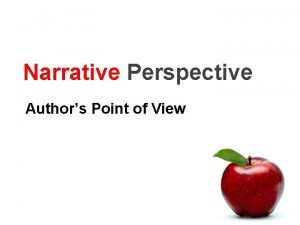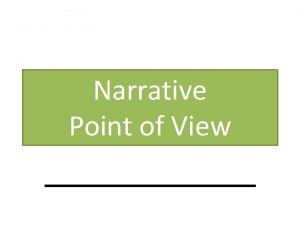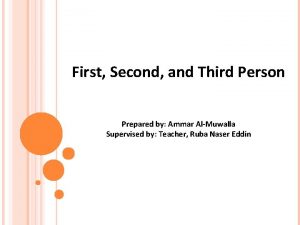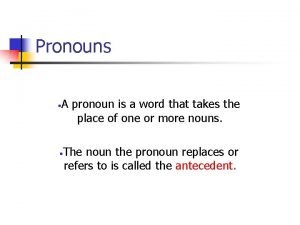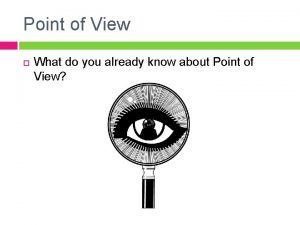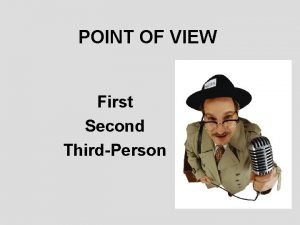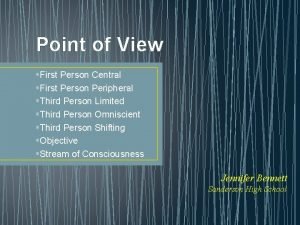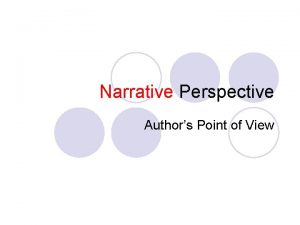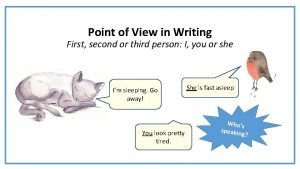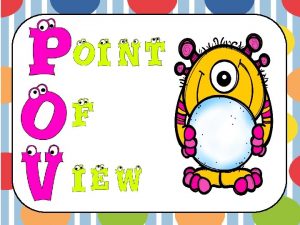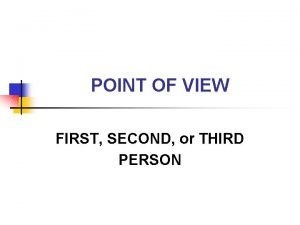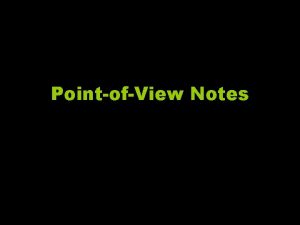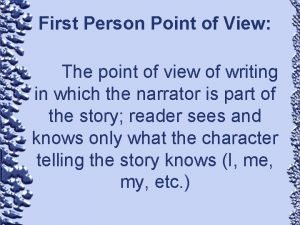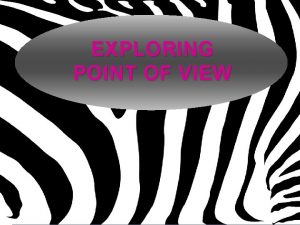Point of View First Person Third Person Limited














- Slides: 14

Point of View First Person, Third Person Limited, Omniscient

First Person Point of View • A narrator who refers to him/herself as “I. ” • Limited to his or her own experiences and thoughts who must guess the feelings, thoughts, or reactions of other characters

Third Person Limited Point of View • The narrator tells the story using third person pronouns (he, she, it, they) but limits to what one character can sense • The limitations are the same as in first person.

Omniscient Point of View • A perspective that can be seen from one character's view, then another's, or can be moved in or out of any character's mind at any time • Reader knows what all the characters are thinking and feeling

Omniscient Point of View Example Laura looked at Brooke, her bestfriend. She had never been jealous of Brooke until now… Brooke knew that Laura was jealous of her. What could she do? Matt asked her out, not Laura…. Appling Aspiration Inc.

Beware of Mixing Points of View • Make sure you stick with one point of view • If you start out telling your story in third person, don’t switch to first person in the middle of it. – For example: Johnny was walking down the hallway one day when all of the sudden, Jordan slammed him into a locker. I couldn’t believe Jordan did that to me. He had no right to slam me into a locker! Johnny kept walking, and I was angry when I got to first period. • The reader will be confused as to who is telling the story if you do this

Point of View and Character Perspective • When you write from the point of view of a character, you must get inside their head! • Don’t just tell the readers what is happening to the main character; show the readers the character’s REACTIONS to the events happening in your story. • When you are showing your character’s REACTIONS, are living in their perspective.

Ways to Show Character Perspective (Reactions) • • Body language Way they say things Their thoughts Other character’s reactions – Body language – The way they say things

Telling a Story Adding Little Character Perspective • Johnny was a boy of about 13. He had no friends, and people were always ignoring him whenever he tried to talk to them. Johnny couldn’t understand why people ignored him so much. • SNOOZE! We know about the events, but the writer is not SHOWING Johnny’s reaction to what is happening to him.

Same Scenario, But Told Through Johnny’s Perspective • Johnny shuffled through the crowded hallway, and he couldn’t help but feel the sting of loneliness as the laughter and conversations of his fellow classmates floated by him. He tried to make eye contact with someone, anyone, but found, as it always had been in his 13 years, no one cared to pay him any attention. Why am I so invisible? Johnny wondered.

Telling a Story Adding Little Character Perspective • Brandy and Sarah were best friends. They had been best friends since kindergarten, but lately Brandy had started hanging with a new group of people. These people did not like Sarah as much and treated her as if she were a pain. Brandy and Sarah end up not being friends in the end. • SNOOZE! We know about the events, but the writer is not SHOWING Sarah’s reaction to what is happening to her.

Same Scenario, But Told Through Sarah’s Perspective “Hi!” Sarah nervously called out as she walked up to join Brandy and her new group of friends. Her greeting was met with eye rolls and quiet sighs. Some even turned their backs away when Sarah entered the circle. “Oh, hey, Sarah, ” Brandy awkwardly greeted back. Brandy’s eyes bounced from face to face of each girl in the circle; then finally, her eyes met Sarah’s and that’s when Sarah knew things were about to change for both of them. She knew there would be no more late night slumber parties or prank texting guys. This was the moment when their long friendship would come to a sad end.

Same Scenario, But Told Through Sarah’s Perspective “Hi!” Sarah nervously called out as she walked up to join Brandy and her new group of friends. Her greeting was met with eye rolls and quiet sighs. Some even turned their backs away when Sarah entered the circle. “Oh, hey, Sarah, ” Brandy awkwardly greeted back. Brandy’s eyes bounced from face to face of each girl in the circle; then finally, her eyes met Sarah’s and that’s when Sarah knew things were about to change for both of them. She knew there would be no more late night slumber parties or prank texting guys. This was the moment when their long friendship would come to a sad end.

Ways to Show Character Perspective (Reactions) • • Body language Way they say things Their thoughts Other character’s reactions – Body language – The way they say things
 Third person point of view examples
Third person point of view examples Point of views in a story
Point of views in a story First person second person third person chart
First person second person third person chart Is the word that a pronoun
Is the word that a pronoun Clue words for point of view
Clue words for point of view 3rd person omniscient
3rd person omniscient Third person example
Third person example Why is point of view important
Why is point of view important Third person omniscient point of view examples
Third person omniscient point of view examples Rising action of a story
Rising action of a story Lina mayfleet character traits
Lina mayfleet character traits What is third person limited
What is third person limited Third person point of view
Third person point of view First person vs third person writing
First person vs third person writing Third person limited
Third person limited
